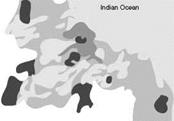In the previous examples specific parcels of land have been set aside for urban agriculture. An alternative strategy has been developed in Tanzania and Bulgaria, where a less specific categorisation or zoning is applied. In each case it has been proposed that as one moves away from the urban centre, the potential for including urban agriculture increases, as more open space becomes available. Thus particular parcels of land are not zoned for food growing, but the extent of urban agriculture acceptable in different areas is defined.
Dar es Salaam, Tanzania
In Dar es Salaam, Tanzania, the city’s Strategic Urban Development Plan now accepts urban agriculture as a legitimate land use, where before it was only tolerated as a transitional land use (Kitilla and Mlambo, 2001). Kitilla and Mlambo refer to the rapid increase of informal urban agriculture in the city, for example between 1985 and 1993 the city witnessed a thirty-fold increase in the number of goats. So planning policy has had to react to a situation which is occurring anyway. It is estimated that 30 per cent of the food consumed in Dar es Salaam is grown within the city boundary.
As a consequence of supporting urban agriculture, the city authorities promote the vertical expansion of buildings, where this can free up urban land for food growing. In Dar es Salaam, the availability of
|
|
4
Highly available areas for city expansion Moderately available for city expansion Less available for city expansion Forest reserve, mangroves or swampy areas Built-up area
Figure 23.5
low cost transport has been recognised as essential for the transportation of locally grown food. Here again we can imagine how interconnected parcels of productive landscape can generate horizontal intensification, and by providing routes for the distribution of goods by, for example, bike, as in Cuba, also provide an infrastructure for local commuting and leisure.
Trojan, Bulgaria
The town of Trojan in Bulgaria provides an example of places where urban food growing occurs in
Industrial zone
![]()
![]()
 Central zone (no animals allowed)
Central zone (no animals allowed)
I I Mixed residential (restricted animal breeding) I I Peripheral villages (animal breeding allowed)
Prevailingly residential (restricted number of domestic animals)
River
residential areas and is consumed by the growers, rather than being sold. Although urban agriculture has not been considered in urban planning, the fact that it exists and makes a significant contribution for a section of the population has resulted in the development of ‘Experimental Rules’ for urban agriculture (Yoveva and Mishev, 2001).
Planners instigated a participatory process, with local farmers and gardeners, to investigate the development of planning policy for urban agriculture. An action plan for the promotion of peri-urban agriculture has been adopted, which commits the
municipality to co-ordinating support structures for the implementation of agricultural projects.
In the initial stages most gardeners have expressed an interest in self-sufficiency, rather than developing commercial market gardens, however the planning team have identified the development of agrotourism and landscape conservation as long-term goals for their productive urban landscapes.
The example of Trojan raises significant questions in relation to suburbia and sprawl. Yoveva and Mishev observe that urban agriculture in Bulgaria,
as practised by individuals for self-consumption, is largely provoked by financial hardship as the country undergoes a process of transition to an open market. From this we can make a reasonable deduction that the majority of the population do not wish to grow their own food, and hence our contention that sustainable cities should make provision for productive landscapes which contain commercially viable mini or supermarket gardens (Viljoen and Tardiveau, 1998). But, by rejecting the notion of individual self-sufficiency, we should not lose site of the opportunities within existing suburbs for extensive food growing. Studies from Auckland in New Zealand have indicated the significance of garden vegetable plots within suburbs and the trend for these to become under-utilised in recent years (Ho, 2000). This extensive area of under-utilised land suggests ways in which portions of private gardens could be connected into a network of linear fields, farmed professionally by gardeners who would supply produce to home owners.
Readers who would like more information about these and other initiatives are directed to The Urban Agriculture Magazine, Number 4 (2001) published by The Resource Centre for Urban Agriculture and Forestry, RUAF. Copies may be downloaded from their website at www. ruaf. org.




